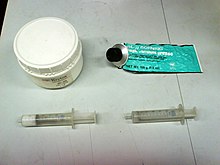Hermetic seal
This article has multiple issues. Please help improve it or discuss these issues on the talk page. (Learn how and when to remove these template messages)
|
A hermetic seal has the quality of being airtight. In common usage, the term often implies being impervious to gasses. When used technically, it is stated in conjunction with a specific test method and conditions of usage.
Etymology
The word hermetic comes from the name of the Greek god Hermes, via the vocabulary of alchemy. The alchemists invented a process for making a glass tube airtight, which was used in distillation. The process used a secret seal whose invention was attributed to the legendary patron of alchemy, Hermes Trismegistos.
Uses
Several types of packaging need to maintain a seal against flow of gases: foods, pharmaceuticals, several chemicals and some consumer goods. The term can be used to describe the food preservation practices such as vacuum packing and canning. Barrier packaging includes containers such as glass, aluminum cans, metal foils, and high barrier plastics.
Building envelopes designed with sustainable architecture use airtight technologies for energy conservation projects. Under the low energy building, passive house, low-energy house, self-sufficient homes, zero energy building, and superinsulation standards, structures are required to be extremely air-tight compared to conventional construction. Air barriers, careful sealing of every construction joint in the building envelope, and sealing of all service penetrations through it are all used to achieve this. Airtightness minimizes the amount of warm (or cool) air that can pass through the structure, enabling the mechanical ventilation system to recover the heat before discharging the air externally. In green building, windows combine triple-pane insulated glazing with the airtight void between panes filled with argon or krypton gas to reduce thermal conductivity and increase R-value (insulation) efficiency. In landscape and exterior construction projects airtight seals are used for general service and landscape lighting electrical connections and splices; and in other specific applications, needing to meet "airtight" standards to be "waterproof" and/or "vapor-proof" for human safety and proper functioning.
Applications for hermetic sealing include semiconductor electronics, thermostats, optical devices, MEMS, and switches. It is used for electrical or electronic parts that are designed and intended to secure against the entry of water vapor and foreign bodies in order to maintain the proper functioning and reliability of their contents.
Hermetic sealing for airtight conditions is used in archiving significant historical items. In 1951, The U.S. Constitution, U.S. Declaration of Independence and U.S. Bill of Rights were hermetically sealed with helium gas in glass cases housed in the U.S. National Archives in Washington, DC. In 2003, they were moved to new glass cases hermetically sealed with argon.[1]
Glassware sealing
Sealing solids

Glass taper joints can be sealed hermetically with PTFE sealing rings,[2] o-rings (optionally encapsulated o-rings), or PTFE sleeves,[3] sometimes used instead of grease that can dissolve into contamination. PTFE tape, PTFE resin string, and wax are other alternatives that are finding widespread use, but require a little care when winding onto the joint to ensure a good seal is produced.
Grease

A rather thin layer of grease particularly made for this application can be applied to the ground glass surfaces to be connected and the inner joint is inserted into the outer joint such that the ground glass surfaces of each are next to each other to make the connection. In addition to making a leak-tight connection, the grease allows two joints to be later separated more easily.[4] However, a potential drawback of using such grease is that if it is used on laboratory glassware for an extended period of time in high-temperature applications (such as for continuous distillation), the grease may eventually cause contamination of the chemicals.[4] Also, reagents may react with the grease which is prone to occurring when the system is under vacuum. For these reasons, it is advisable to apply a light ring of grease at the fat end of the taper and not its tip, to keep the material away from insides of the glassware. If the grease smears over the entire taper surface on mating, too much is being used. Using greases specifically designed for this purpose is also a good idea, as these are often better at sealing under vacuum, thicker and so less likely to flow out of the taper, become fluidic at higher temperatures than Vaseline (a common substitute) and are more chemically inert than other substitutes.
Cleaning
Ground glass joints are translucent and physically free of debris when clean. Solvents, reaction mixtures, and old grease show up as transparent spots. Grease can be removed by wiping with an appropriate solvent; ether, methylene chloride, ethyl acetate, or hexanes work well for silicone- and hydrocarbon-based greases. Fluoroether-based greases are quite impervious to organic solvents; most chemists simply wipe them off as much as possible. That said, there are fluorinated solvents available which can remove fluoroether greases, but they are much more expensive than laboratory solvents.[5]
Testing
Standard test methods are available for measuring the moisture vapor transmission rate, oxygen transmission rate, etc. of packaging materials. Completed packages, however, involve heat seals, joints, and closures which often reduce the effective barrier of the package. For example, the glass of a glass bottle may have an effective total barrier but the screw cap closure and the closure liner might not.
See also
Notes
- ^ "Origins of the Charters of Freedom Project". 2001-06-25. Retrieved 2011-06-12.
- ^ Glindemann, D., Glindemann, U. (2000). Tight glassware for ST cones and stoppers, selflubricating, withstand temperature up to + 220 °C with PTFE-sealing ring for taper joints., American Laboratory 32 (5): 46–48 – a comparison of PTFE rings with PTFE sleeves)
- ^ Loughborough Glass Co., Ltd. (1957). "Sleeves to replace grease in ground glass joints". Journal of Scientific Instruments. 34: 38. Bibcode:1957JScI...34...38L. doi:10.1088/0950-7671/34/1/429.
- ^ a b Rob Toreki (2006-12-30). "Glassware Joints". Interactive Learning Paradigms Inc.
- ^ http://www.2spi.com/catalog/vac/perfluorosolv.shtml
